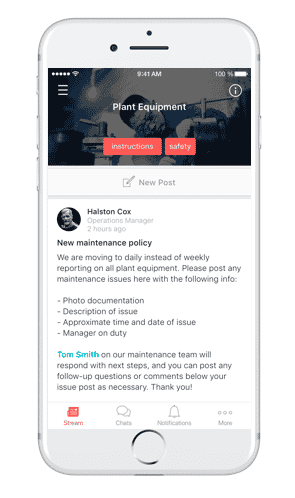Communication between departments, especially inter-departmental communication, is one of several organizational functions that help to keep any enterprise efficient and productive.
Although it’s one function that is often overlooked or taken for granted, the importance of good internal communication becomes evident whenever there is a communication breakdown. In any manufacturing plant, one of the closest departments to the manufacturing process is the maintenance team. However, this does not mean that maintenance can afford to work in isolation. In fact, the reality is just the opposite.
If the maintenance team has the culture of proceeding with repairs or servicing without informing other departments, it can cost the manufacturer dearly in the form of missed orders, product quality issues, safety problems, and more.
Here are the top reasons why good communication between maintenance and other manufacturing departments is so important – and how digital communication tools can facilitate this.
Improve Communication Between Departments: Better Informed Plant Employees Minimizes Uncertainties
Manufacturing staff that are uncertain about daily work tasks or operational processes can hardly be expected to be productive. Unfortunately, this can be present across all departments, not just maintenance teams. Because of its often specialized nature, the successful completion of any maintenance task depends on good and clear communication between departments.
When technicians don’t know exactly what to do, they may waste time either trying to decipher what the problem is or waiting for further work instructions.
This kind of issue typically occurs when an employee from another unit needs maintenance attention but lacks the resources needed to quickly convey the request. For instance, someone from outside the production floor, such as at the front desk, is requesting for repairs of faulty equipment but they can’t adequately explain what the problem is.
Likewise, it could be that the instructions for a maintenance technician are vague because the employee raising the job request is busy and so they don’t take the time to give all the information needed.
Digital Operational Communication Connects Dispersed Workforces in Manufacturing Departments and More
While these examples may not sound like such a big deal if technicians are readily available round the clock, it’s a major problem if the technician is coming from a separate work site, distant location or manufacturing departments.
Such situations can result in confusion and frustration but are easily avoided if the organization is already employing proactive team communication tools like mobile-enabled CMMS or an employee communication app that allows staff to forgo time-consuming paperwork and instantly upload pictures or videos with service requests.

The ultimate goal should be to promote a company culture where employees know that adequately describing the problem with enough detail will allow maintenance technicians to solve their problem faster.
Improve Plant Floor Safety and Trust
Machine operators are normally the first to know when an equipment isn’t functioning properly. As your organization’s primary frontline workers with manufacturing equipment, they are an ideal go-to resource and can tell when there’s a problem.
Consequently, it’s important not to overlook their input or their feedback when it comes to production goals and worker safety. It is critical that operators, cleaners, and other staff are encouraged to communicate any observations to maintenance as a matter of urgency. Failure to do this can cause severe problems, especially during shift transitions.
Accidents occur when there is lack of collaboration between machine operators, production floor team, and maintenance personnel. All it takes is one accident for workers to lose trust in the maintenance team and vice versa. This becomes obvious in blame-trading, poor teamwork, and even friction among the different departments.
A team communication tool is a fitting way to encourage the flow of inter-departmental information via digital communication channels, where staff can be encouraged to air their opinions, observations, and suggestions on dedicated communication streams. This also saves time and money by eliminating the need for so many in-person meetings.
How to Improve Communication Between Departments : Boost Productivity and Brand Image
Increased competition means manufacturers want to work with fewer staff but still maintain the same level of productivity and production quality as before. Unfortunately, this can be tricky to manage especially for factories that are not yet using automated systems.
Imagine a situation where maintenance is short-staffed, busy, and somehow forgets to inform production that they are shutting down a packing machine for 12 hours. The result is chaos and missed deadlines, which can result in angry customers. This kind of miscommunication often stifles or completely halts production.
To address this, top-level management can be more involved in the organization’s productivity efforts by implementing digital communication tools. One way to do this is by listening to the input of maintenance managers and working with them to ensure the maintenance team has all it needs to get the job done.
By working with feedback from maintenance and other units as well, management can lay out better operational strategies and plans that will keep every unit running smoothly and then communicate these plans to all levels of employees in a way that everyone can understand. This can help them learn how to improve communication between departments.
Although good employee communication is considered a soft skill, its absence can lead to friction between every major department in a business and affect the bottom line.
Deploying an effective, accessible, and mobile communication platform is a first step to make sure manufacturing employees feel informed, heard, and connected.
Download our USA Compression case study to learn more about how a tool can better connect dispersed manufacturing teams and streamline operations.
Most Frequently Asked Questions
Communication between departments is also referred to as inter-departmental communication
Working with digital tools such as Beekeeper is a prefect way to facilitate inter-departmental communication.







